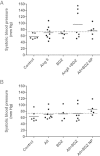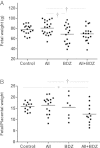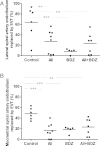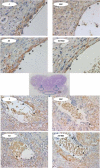Administration of angiotensin II and a bradykinin B2 receptor blocker in midpregnancy impairs gestational outcome in guinea pigs
- PMID: 24893657
- PMCID: PMC4062647
- DOI: 10.1186/1477-7827-12-49
Administration of angiotensin II and a bradykinin B2 receptor blocker in midpregnancy impairs gestational outcome in guinea pigs
Abstract
Background: The opposing renin-angiotensin system (RAS) and kallikrein-kinin system (KKS) are upregulated in pregnancy and localize in the utero-placental unit. To test their participation as counter-regulators, circulating angiotensin II (AII) was exogenously elevated and the bradykinin B2 receptor (B2R) was antagonized in pregnant guinea-pigs. We hypothesized that disrupting the RAS/KKS balance during the period of maximal trophoblast invasion and placental development would provoke increased blood pressure, defective trophoblast invasion and a preeclampsia-like syndrome.
Methods: Pregnant guinea-pigs received subcutaneous infusions of AII (200 μg/kg/day), the B2R antagonist Bradyzide (BDZ; 62.5 microg/kg/day), or both (AII + BDZ) from gestational day 20 to 34. Non-pregnant cycling animals were included in a control group (C NP) or received AII + BDZ (AII + BDZ NP) during 14 days. Systolic blood pressure was determined during cycle in C NP, and on the last day of infusion, and 6 and 26 days thereafter in the remaining groups. Twenty six days after the infusions blood and urine were extracted, fetuses, placentas and kidneys were weighed, and trophoblast invasion of spiral arteries was defined in the utero-placental units by immunocytochemistry.
Results: Systolic blood pressure transiently rose in a subgroup of the pregnant females while receiving AII + BDZ infusion, but not in AII + BDZ NP. Plasma creatinine was higher in AII- and BDZ-treated dams, but no proteinuria or hyperuricemia were observed. Kidney weight increased in AII + BDZ-treated pregnant and non-pregnant females. Aborted and dead fetuses were increased in dams that received AII and AII + BDZ. The fetal/placental weight ratio was reduced in litters of AII + BDZ-treated mothers. All groups that received interventions during pregnancy showed reduced replacement of endothelial cells by extravillous trophoblasts in lateral and myometrial spiral arteries.
Conclusions: The acute effects on fetal viability, and the persistently impaired renal/placental sufficiency and incomplete arterial remodeling implicate the RAS and KKS in the adaptations in pregnancy. The results partially confirm our hypothesis, as a preeclampsia-like syndrome was not induced. We demonstrate the feasibility of characterizing systemic and local modifications in pregnant guinea-pig, supporting its use to study normal placentation and related disorders.
Figures




Similar articles
-
Bradykinin Exerts Independent Effects on Trophoblast Invasion and Blood Pressure in Pregnant Guinea Pigs.Reprod Sci. 2020 Aug;27(8):1648-1655. doi: 10.1007/s43032-020-00195-6. Reprod Sci. 2020. PMID: 32430711
-
Bradykinin Exerts Independent Effects on Trophoblast Invasion and Blood Pressure in Pregnant Guinea Pigs.Reprod Sci. 2019 Mar 5:1933719119833494. doi: 10.1177/1933719119833494. Online ahead of print. Reprod Sci. 2019. PMID: 30836849
-
OS059. Blockade of the bradykinin B2 receptor in early pregnancy reduces fetal growth and trophoblast invasion in guinea-pigs.Pregnancy Hypertens. 2012 Jul;2(3):208-9. doi: 10.1016/j.preghy.2012.04.060. Epub 2012 Jun 13. Pregnancy Hypertens. 2012. PMID: 26105273
-
Review: The angiogenic and vasodilatory utero-placental network.Placenta. 2011 Mar;32 Suppl 2:S170-5. doi: 10.1016/j.placenta.2011.01.008. Epub 2011 Feb 4. Placenta. 2011. PMID: 21295852 Review.
-
[Role of the renin-angiotensin system in pregnancy and preeclampsia].Hipertens Riesgo Vasc. 2020 Apr-Jun;37(2):72-77. doi: 10.1016/j.hipert.2020.02.003. Epub 2020 Mar 5. Hipertens Riesgo Vasc. 2020. PMID: 32147515 Review. Spanish.
Cited by
-
Correlation between the severity of endometriosis and the occurrence of placenta accreta spectrum in the subsequent pregnancy.Pak J Med Sci. 2025 Jan;41(1):55-63. doi: 10.12669/pjms.41.1.11145. Pak J Med Sci. 2025. PMID: 39867784 Free PMC article.
-
Bradykinin Exerts Independent Effects on Trophoblast Invasion and Blood Pressure in Pregnant Guinea Pigs.Reprod Sci. 2020 Aug;27(8):1648-1655. doi: 10.1007/s43032-020-00195-6. Reprod Sci. 2020. PMID: 32430711
References
-
- Chen S, Patel JM, Block ER. Angiotensin IV-mediated pulmonary artery vasorelaxation is due to endothelial intracellular calcium release. Am J Physiol Lung Cell Mol Physiol. 2000;279:L849–L856. - PubMed
Publication types
MeSH terms
Substances
LinkOut - more resources
Full Text Sources
Other Literature Sources
Miscellaneous

